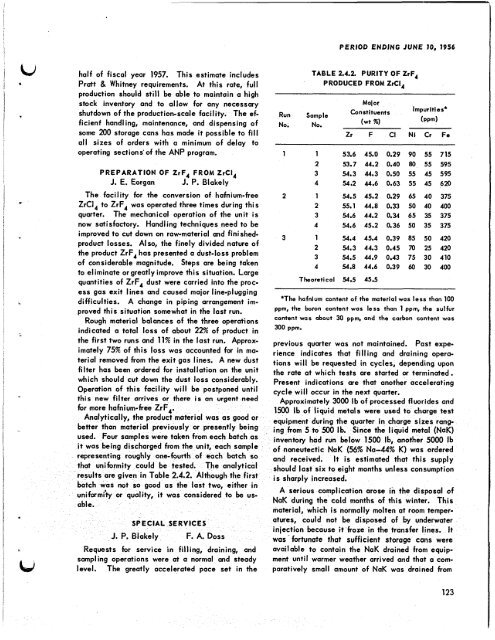ORNL-2106 - the Molten Salt Energy Technologies Web Site
ORNL-2106 - the Molten Salt Energy Technologies Web Site
ORNL-2106 - the Molten Salt Energy Technologies Web Site
Create successful ePaper yourself
Turn your PDF publications into a flip-book with our unique Google optimized e-Paper software.
half of fiscal year 1957. This estimate includes<br />
Pratt & Whitney requirements. At this rate, full<br />
production should still be able to maintain a high<br />
stock inventory and to allow for any necessary<br />
shutdown of <strong>the</strong> production-scale facility. The ef-<br />
ficienf hand1 ing, maintenance, and dispensing of<br />
some 200 storage cans has made it possible to fill<br />
all sizes of orders with a minimum of delay to<br />
operating sections'of <strong>the</strong> ANP program.<br />
PREPARATION OF ZrF, FROM ZrCI4<br />
J. E. Eorgan J. P. Blakely<br />
The facility for <strong>the</strong> conversion of hafnium-free<br />
ZrCI, to ZrF, was operated three times during this<br />
quarter. The mechanical operation of <strong>the</strong> unit is<br />
now satisfactory. Handling techniques need to be<br />
improved to cut down on raw-material and finishedproduct<br />
losses. Also, <strong>the</strong> finely divided nature of<br />
<strong>the</strong> product ZrF, has presented a dust-loss problem<br />
of considerable magnitude. Steps are being taken<br />
to eliminate or greatly improve this situation. Large<br />
quantities of ZrF, dust were carried into <strong>the</strong> proc-<br />
..<br />
ess gas exit lines and caused major line-plugging<br />
difficulties. A change in piping arrangement im-<br />
proved this situation somewhat in <strong>the</strong> last run.<br />
Rough material balances of <strong>the</strong> three operations<br />
indicated a total loss of about 22% of product in<br />
<strong>the</strong> first two runs and 11% in <strong>the</strong> last run. Approx-<br />
imately 75% of this loss was accounted for in ma-<br />
terial removed from <strong>the</strong> exit gas lines. A new dust<br />
filter has been ordered for installation on <strong>the</strong> unit<br />
which should cut down <strong>the</strong> dust loss considerably.<br />
Operation of this facility will be postponed until<br />
this new filter arrives or <strong>the</strong>re is an urgent need<br />
for more hafnium-free ZrF,.<br />
Analytically, <strong>the</strong> product material was as good or<br />
better than material previously or presently being<br />
used. Four samples were taken from each batch as<br />
it was being discharged from <strong>the</strong> unit, each sample<br />
representing roughly one-fourth of each batch so<br />
uld be tested. The analytical<br />
esults are given in Table 2.4.2. Although <strong>the</strong> first<br />
batch was not SO good as <strong>the</strong> last two, ei<strong>the</strong>r in<br />
uniformhy or quality, it was considered to be us-<br />
able.<br />
ClAL SERVIC<br />
F. S<br />
Requests for service in filling, draining, and<br />
sampling operations were at a normal and steady<br />
level. The greatly accelerated pace set in <strong>the</strong><br />
Run Sample<br />
No. No.<br />
PERIOD ENDJNG JUNE 10, 1956<br />
TABLE 2.4.2. PURITY OF ZrF,<br />
PRODUCED FROM ZrC14<br />
Maior<br />
Constituents lmpur i ti et*<br />
(wt so)<br />
(PPd<br />
Zr F CI Ni Cr Fa<br />
1 1 53.6 45.0 0.29 90 55 715<br />
2 53.7 44.2 0.40 80 55 595<br />
3 54.3 44.3 0.50 55 45 595<br />
4 54.2 44.6 0.63 55 45 620<br />
2 1 54.5 45.2 0.29 65 40 375<br />
2 55.1 44.8 0.33 50 40 400<br />
3 54.6 44.2 0.34 65 35 375<br />
4 54.6 45.2 0.36 50 35 375<br />
3 1 54.4 45.4 0.39 a5 50 420<br />
2 54.3 44.3 0.45 70 25 420<br />
3 54.5 44.9 0.43 75 30 410<br />
4 54.8 44.6 0.39 60 30 400<br />
Theoretical 54.5 45.5<br />
'The hafnium content of <strong>the</strong> material was less than 100<br />
ppm, <strong>the</strong> boron content was lest than 1 ppm, <strong>the</strong> sulfur<br />
content was about 30 ppm, and <strong>the</strong> carbon content was<br />
300 ppm.<br />
previous quarter was not maintained. Past expe-<br />
rience indicates that filling and draining opera-<br />
tions will be requested in cycles, depending upon<br />
<strong>the</strong> rate at which tests are started or terminated.<br />
Present indications are that ano<strong>the</strong>r accelerating<br />
cycle will occur in <strong>the</strong> next quarter.<br />
Approximately 3000 Ib of processed fluorides and<br />
1500 Ib of liquid metals were used to charge test<br />
equipment during <strong>the</strong> quarter in charge sizes rang-<br />
ing from 5 to 500 Ib. Since <strong>the</strong> liquid metal (NaK)<br />
inventory had run below 1500 Ib, ano<strong>the</strong>r 5000 Ib<br />
of noneutectic NaK (56% Na-44% K) was ordered<br />
and received. It is estimated that this supply<br />
should last six to eight months unless consumption<br />
is sharply increased.<br />
A serious complication arose in <strong>the</strong> disposal of<br />
NaK during <strong>the</strong> cold months of this winter. This<br />
material, which is normally molten at room temper-<br />
atures, could not be disposed of by underwater<br />
injection because it froze in <strong>the</strong> transfer lines. It<br />
was fortunate that sufficient storage cans were<br />
available to contain <strong>the</strong> NaK drained from equip-<br />
ment until warmer wea<strong>the</strong>r arrived and that a com-<br />
paratively small amount of NaK was drained from<br />
~<br />
123



![Review of Molten Salt Reactor Physics Calculations [Disc 2]](https://img.yumpu.com/21979492/1/190x247/review-of-molten-salt-reactor-physics-calculations-disc-2.jpg?quality=85)













